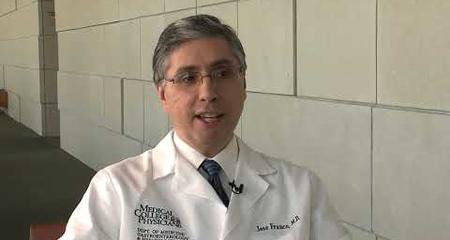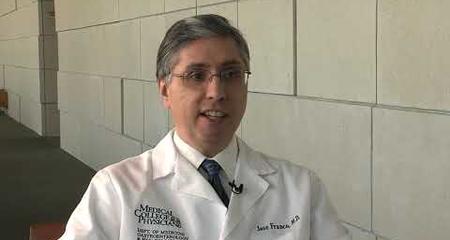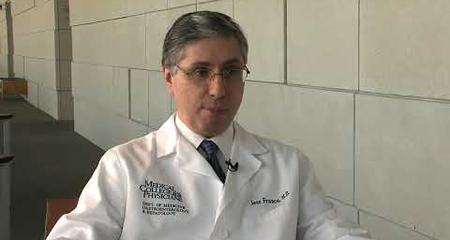Benign esophageal diseases tend to deal with motility problems, or how food moves through the esophagus.
Esophageal Diseases and Disorders
Gastroesophageal Reflux Disease (GERD)
GERD occurs when stomach acid backs up into the esophagus, causing a burning sensation (also called acid reflux disease). Symptoms typically occur two or more days a week for at least three months. GERD occurs because the valve separating the esophagus and stomach does not close properly. About 30 million Americans suffer daily from GERD.
People with chronic acid reflux may experience a variety of symptoms including heartburn, regurgitation of food, swallowing difficulties, excessive belching, hoarseness, sore throat, frequent throat clearing, non-cardiac chest pain, chronic cough, sleeping problems, sinusitis or breathing problems such as shortness of breath or wheezing.
The complications of GERD can extend beyond the esophagus. GERD can damage the lining of the esophagus, resulting in a narrowing (stricture) of the esophagus. This can affect the functioning of the esophagus.
LINX Reflux Management System to Treat GERD
One option to treat GERD is the LINX® Reflux Management System, which involves a medical device implanted with a minimally invasive surgical procedure.
Barrett’s Esophagus
Barrett's Esophagus or Barrett's Dysplasia develops in some people who have chronic GERD or inflammation of the esophagus (esophagitis). In Barrett’s esophagus, the normal (squamous) cells that line the esophagus turn into a type of cell called specialized columnar cells. Damage to the lining of the esophagus (by acid reflux) causes these abnormal changes. Once the cells have turned into columnar cells, they will not revert back to normal. Not all patients with GERD get Barrett’s, but nearly all patients with Barrett’s have GERD. Up to 1 percent of people with Barrett’s esophagus develop esophageal cancer.
Dysphagia
Dysphagia—difficulty in swallowing—affects about one out of every 17 persons. The Dysphagia Institute is committed to the diagnosis, research and treatment of people with dysphagia and acid reflux disease.
Gastroesophageal Motility Disorders
Gastroesophageal motility disorders are weak or uncoordinated muscular contractions of the esophagus, interfering with the movement of food or fluid from the throat to the stomach.
- Achalasia — a common motility problem where the sphincter at the bottom part of the esophagus (the valve between the end of the esophagus and the beginning of the stomach) is permanently closed. Food can pass through, but it never really opens up.
- Diffuse esophageal spasm — uncoordinated contractions of the esophagus that affect the movement of food to the stomach. It can cause difficulty swallowing, regurgitation and chest pain.
- Esophageal diverticula — weak areas of the esophagus that bulge or pouch outwards
- Paraesophageal hernia — occurs when a portion of the stomach goes up into the chest next to the esophagus.
Benign Esophageal Tumors
The most common type of benign esophageal tumors are called leiomyomas, and they generally occur in smooth muscle.
Eosinophilic Esophagitis
Eosinophilic esophagitis is an inflammatory condition in which the wall of the esophagus becomes filled with large numbers of eosinophils (white blood cells produced in bone marrow that actively promote inflammation, particularly inflammation caused by allergic reactions). The most common cause of eosinophilic esophagitis is allergy-induced inflammation.
Esophageal Surgery
While many esophagus disorders can be treated medically, when symptoms are severe, surgery may be necessary.
An anti-reflux surgical procedure called a Nissen Fundoplication is very effective in controlling symptoms of GERD, Barrett's Esophagus, dysplasia and achalasia.
Another surgical procedure called a myotomy, in which the thick muscle of the esophagus and stomach is cut, is used to relieve dysphagia and achalasia.
Esophageal surgery can be done different ways, depending on the individual patient’s needs and condition. In many cases, surgery can be done with minimally invasive techniques using the da Vinci® robotic surgical system, a laparoscope or video-assisted thoracic surgery (VATS). Our surgeons are skilled in all of these techniques, which translate into smaller incisions, less pain, quicker recovery times and other benefits for patients.
At Froedtert & the Medical College of Wisconsin, patients receive the highest quality, most comprehensive, multidisciplinary care that is tailored to their individual needs.
Recognized as High Performing by U.S. News & World Report
Froedtert Hospital is recognized by U.S. News & World Report as high performing in three adult specialties and 16 procedures and conditions, including gastroenterology and GI surgery.Virtual Visits Are Available
Safe and convenient virtual visits by video let you get the care you need via a mobile device, tablet or computer wherever you are. We'll assess your condition and develop a treatment plan right away. To schedule a virtual visit, call 414-777-7700.





